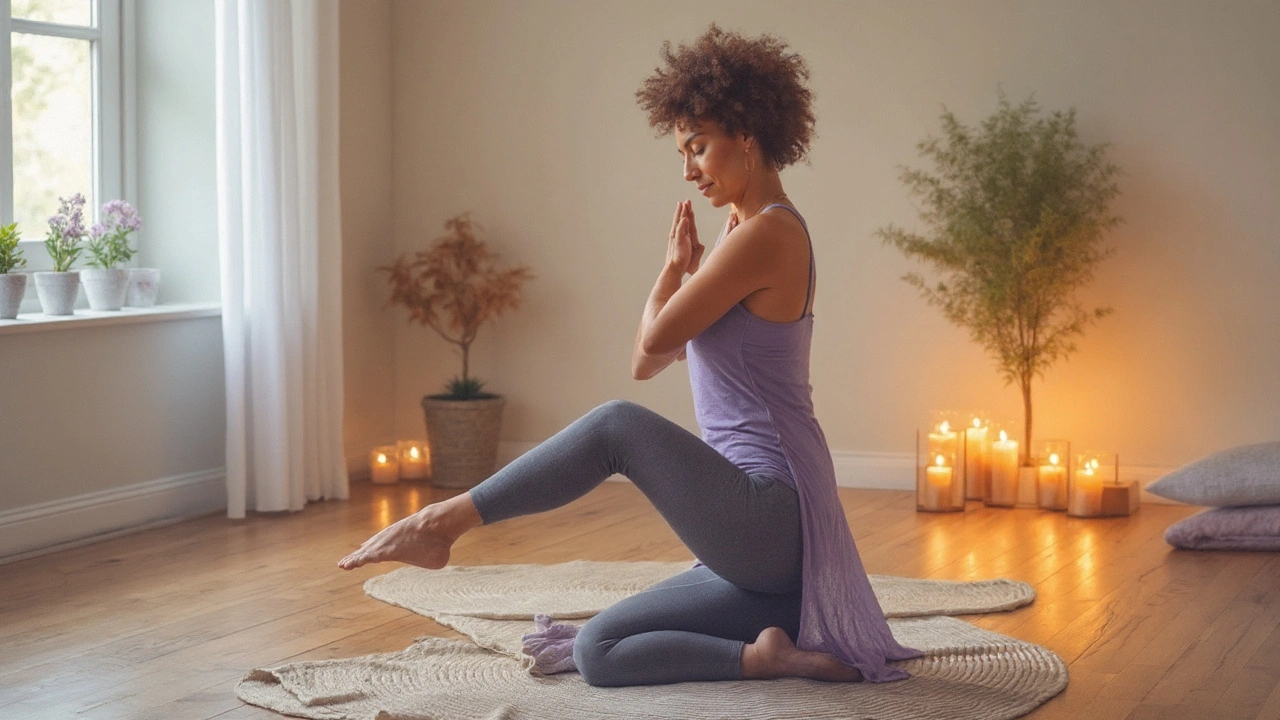Fibromyalgia is a chronic pain syndrome marked by widespread musculoskeletal aches, deep‑seated fatigue, and disrupted sleep. For many, the idea of moving feels like stepping into a minefield - too much activity can spark flare‑ups, yet a sedentary life worsens stiffness. The sweet spot lies in a carefully calibrated routine that eases pain without overloading the nervous system. Below you’ll find a step‑by‑step roadmap that blends science, real‑world stories, and practical tools so you can finally feel that exercise can be a friend, not a foe.
Why Exercise Matters for Fibromyalgia
Exercise is a planned, structured physical activity that improves or maintains fitness. Research from the American College of Rheumatology shows that regular, moderate‑intensity movement can lower pain scores by up to 30% and improve quality of life for people with fibromyalgia.
During activity the brain releases endorphins, natural chemicals that act as pain‑modulating agents. Over time, consistent movement also helps reset the central nervous system’s heightened sensitivity, a core issue in fibromyalgia. The result isn’t a miracle cure, but a tangible reduction in daily aches, better sleep, and more energy for the things you love.
Exercise Types That Tend to Work Best
Not all workouts are created equal. Below is a quick snapshot of three categories that repeatedly show positive outcomes in clinical trials and patient reports.
| Modality | Typical Intensity (RPE1‑10) | Suggested Session Length | Key Pain‑Relief Benefit |
|---|---|---|---|
| Aerobic training | 3‑5 | 20‑30min | Improves cardiovascular health and endorphin release |
| Resistance training | 4‑6 | 15‑25min | Boosts muscle strength, supporting joints and reducing strain |
| Mind‑body activity (e.g., yoga, tai chi) | 2‑4 | 30‑45min | Lowers stress hormones, enhances sleep, and gently improves flexibility |
These categories are not mutually exclusive - a balanced plan usually pulls a thread from each.
Designing Your Personal Balance
Start with a realistic baseline. If you’re currently sedentary, a 5‑minute walk three times a week is a legitimate starting point. The goal is to add~5minutes each week, staying within a perceived exertion (RPE) range of 3‑4. This gradual progression respects the body’s pain‑signaling system and minimizes flare‑ups.
- Frequency: Aim for 3‑5 days per week, mixing low‑impact cardio, gentle resistance, and mind‑body sessions.
- Intensity: Keep RPE below 5 on most days. On “good” days you can push to 6, but always listen to pain signals.
- Duration: Begin with 10‑15minutes per session, working up to 30‑45minutes as tolerance improves.
- Rest: Schedule at least one full rest day and incorporate active recovery (stretching, slow walking) on others.
Tracking tools make this easier. A simple notebook or a phone app that logs RPE, pain level (0‑10), and fatigue can reveal patterns - for instance, you may notice that exercising after a poor night’s sleep spikes pain, prompting a later‑day workout instead.
How to Monitor and Adjust
The two most telling metrics are pain relief and fatigue. After each session, rate pain (0=none, 10=worst) and fatigue (same scale). If pain spikes by more than 2 points or fatigue stays above 7 for two consecutive days, dial back intensity or shorten the workout.
Sleep quality is another hidden driver. A study in the Journal of Pain found that participants who improved sleep duration by just 30minutes saw a 12% reduction in daytime pain. If you notice restless nights, consider swapping a high‑intensity cardio day for a gentle yoga flow.

Common Pitfalls and How to Dodge Them
1. Fear‑avoidance: Skipping all activity because of past flare‑ups only reinforces pain pathways. Start small, celebrate tiny wins, and remind yourself that movement is therapeutic, not punitive.
2. All‑or‑nothing mindset: Doing a marathon session once and then quitting for a week creates a roller‑coaster of symptoms. Consistency beats intensity.
3. Ignoring body signals: Pushing through sharp pain can cause injury and set back progress. Use a “stop‑and‑assess” rule - if pain feels different from usual muscle soreness, pause and modify.
4. Lack of variety: Repeating the same 10‑minute walk can lead to boredom and plateaus. Rotate activities every 2‑3 weeks to keep motivation high and challenge different muscle groups.
Related Concepts That Support Exercise Success
Understanding the broader ecosystem helps you stay on track.
- Sleep quality: Aim for 7‑9hours of uninterrupted rest. A cool, dark bedroom and a wind‑down routine (e.g., light stretching) improve deep‑sleep phases that are vital for pain modulation.
- Mood: Exercise lifts serotonin and dopamine, easing the anxiety and depression that often accompany chronic pain. Even a 10‑minute walk can boost mood scores noticeably.
- Stress management: Mind‑body sessions double as stress reducers. Incorporate breathing exercises or guided meditation on rest days.
- Nutrition: Anti‑inflammatory foods (omega‑3 rich fish, leafy greens) can complement the analgesic effect of exercise.
When these pillars align, exercise feels less like a chore and more like a cornerstone of overall well‑being.
Quick‑Start Checklist
- Define a 2‑week trial: 3 days of 10‑minute walking, 1 day of gentle yoga, 1 day of light resistance (e.g., bodyweight squats).
- Log RPE, pain, fatigue, and sleep each night.
- Adjust any day where pain >3 or fatigue >7.
- After two weeks, increase each session by 5minutes if pain trends downward.
- Celebrate consistency, not perfection.
Remember, the aim isn’t to chase a marathon finish line; it’s to keep the pain level low enough to enjoy day‑to‑day activities.
Next Steps for Ongoing Growth
Once you’ve mastered the beginner phase, explore these extensions:
- Join a local fibromyalgia support group that offers group walks or yoga classes.
- Consult a physiotherapist specialized in chronic pain to fine‑tune resistance protocols.
- Track long‑term trends with a spreadsheet: note medication changes, stress events, and weather patterns that can influence pain.
Each layer adds confidence that you’re in control, not at the mercy of unpredictable flare‑ups.

Frequently Asked Questions
Can I start exercising on a bad pain day?
A short, low‑intensity activity like gentle stretching or a five‑minute walk is generally safe. The key is to keep the effort below a perceived exertion of 3 and stop if pain spikes. Often, moving a little can actually break the pain cycle.
How often should I do resistance training?
Two non‑consecutive days per week is a good target. Start with bodyweight moves (e.g., wall push‑ups, seated rows with a resistance band) and aim for 1‑2 sets of 8‑12 repetitions. Increase weight or repetitions only when pain stays low for a full week.
Is high‑intensity interval training (HIIT) ever appropriate?
For most people with fibromyalgia, HIIT is too abrupt and can trigger sympathetic nervous system over‑activation. If you’re an experienced athlete with stable symptoms, a very modified version (30seconds gentle marching, 90seconds rest) might be trialed under professional supervision.
Should I exercise before or after medication?
Timing can affect tolerance. Many report better comfort when they exercise after taking analgesics or muscle relaxants that peak within 30‑60minutes. Always follow your prescriber’s guidance and note any side‑effects.
What’s the role of diet in managing fibromyalgia pain?
A diet rich in omega‑3 fatty acids, antioxidants, and low in processed sugars can reduce systemic inflammation, which may amplify pain signals. Pairing a balanced diet with regular movement often yields the best symptom control.
How do I know if my exercise plan is working?
Track three core metrics for at least four weeks: average pain rating, fatigue level, and sleep quality. If pain drops by 1‑2 points, fatigue stays stable, and sleep improves, the plan is likely effective. Adjust only when trends reverse.


Author
Mike Clayton
As a pharmaceutical expert, I am passionate about researching and developing new medications to improve people's lives. With my extensive knowledge in the field, I enjoy writing articles and sharing insights on various diseases and their treatments. My goal is to educate the public on the importance of understanding the medications they take and how they can contribute to their overall well-being. I am constantly striving to stay up-to-date with the latest advancements in pharmaceuticals and share that knowledge with others. Through my writing, I hope to bridge the gap between science and the general public, making complex topics more accessible and easy to understand.